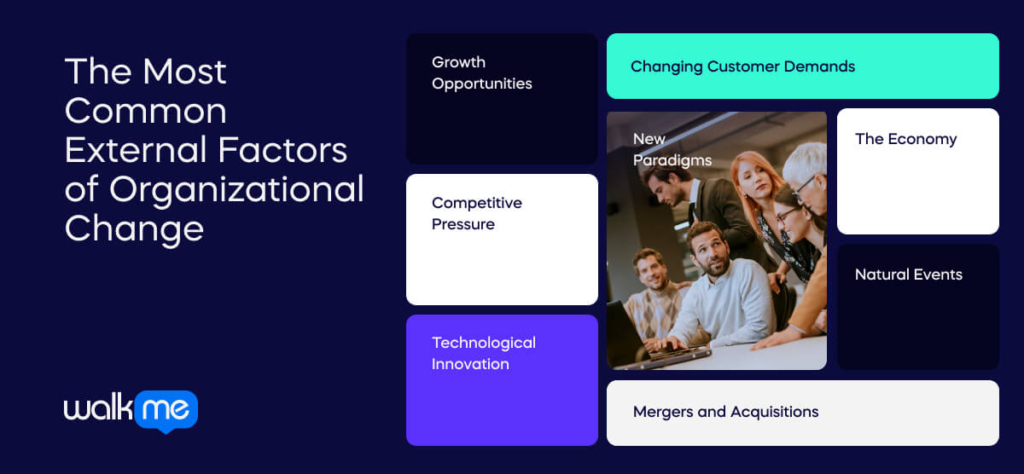What are the biggest external factors of organizational change?
Organizational change can be caused by any number of causes – either internal or external.
Internal causes of change, for instance, can include:
- Structural changes
- Organic cultural changes
- The development of new products or services
And so on.
However, many organizational changes are driven by external forces.
Let’s look at some of those in detail.
What Are the Most Common External Factors of Organizational Change?

In no particular order, here is a list of external factors that can influence or cause organizational changes.
Growth Opportunities
According to a report by Prophet, one of the main drivers of digital transformation is growth opportunities.
Growth opportunities for a business can be opened up through:
- New technology
- Access to new marketplaces
- New products and services
Among many other things.
Competitive Pressure
That same report also named competitive pressure as another major driver of digital transformation.
In an era defined by continual disruption and change, this makes sense.
When competitors use technology to grow, evolve, and gain an edge, organizations must adapt in order to keep up.
Technological Innovation
With new technology comes innovation.
Technology has been used to drive a number of organizational change projects, including:
- Digital adoption
- Business process changes
- The development of new products and services
- Customer experience transformation
Just to name a few.
New Paradigms
Following along these same lines, new paradigms can also drive change.
Just as technology can open new growth opportunities and marketplaces, it can also force paradigm shifts.
Consider all of the technological developments in recent years – the internet, mobile technology, AI, and the blockchain.
All of these are causing a massive paradigm shift in the way we live and work.
To survive, businesses must adapt and change the way they operate.
Changing Customer Demands
Customer demands can also be a source of change.
For instance:
- Customers may begin performing product research online rather than in the store
- Clothing may go in or out of fashion
- Food preferences may change over time
And so forth.
Since customers are the lifeblood of any business, businesses must always strive to meet and exceed customer expectations.
Good solutions to changing customer demands include creating a customer experience culture and refocusing your efforts on customer success – rather than your own products and features.
The Economy
Economic changes can also pressure businesses to change.
A weak economy, for instance, can cause downsizing, budget cuts, business process changes, and so forth.
A strong economy, on the other hand, can have the opposite effects. Organizations may increase investment in any number of areas, from recruitment to product development.
Other specific economic conditions can also impact a business.
These can include tariffs, trade wars, trade agreements, regulations, and so forth.
Natural Events
Another external factor of organizational change is natural events, such as:
- Natural Disasters
- International Conflict
- Commodity Shortages or Surpluses
- Famines or Crop Surpluses
As with every other organizational cause mentioned here, these factors can either be beneficial or negative.
In most cases, whether the effect is negative or positive will depend on the organization.
A trade war may, for instance, may benefit one company while another suffers.
Mergers and Acquisitions
Mergers and acquisitions are also major factors that cause change.
When two companies join forces, the resulting changes can include:
- Restructuring
- Cultural changes
- Changes to business processes
- Recruitment or layoffs
- Rebranding
Among many other changes.
The Importance of Change Management Agility
Clearly, there are many external factors that can cause organizational changes.
Since there is no way to control such external factors, it is critical to maintain change management agility.
That is, organizations should be able to change efficiently, effectively, and quickly.
Here are a few tips that can help organizations stay agile and adaptable:

- Develop agile change management practices. Agile change management, like agile software development, emphasizes responsiveness, collaboration, and user-driven solutions.
- Adopt modern digital tools and technology. Technology can make any business process more effective, efficient, and profitable – change management included. The right change management software can boost productivity, enhance productivity, and decrease waste.
- Use real-time data to improve reaction time. Data and analytics offer insight that can also improve change management agility. Today, real-time data can offer up-to-the-minute insights into change management projects, markets, competitors, and much more. All of this can help change managers act and react more quickly.
- Focus on progress and results over processes. Processes and procedures are great, when they work. But change management should evolve to meet the specific needs of an organization. If current change management processes can’t tackle a specific challenge, feel free to change them.
- Advance your change management department. A business with a more robust change management function will be more adaptable. Their change projects will run smoother, be more efficient, and get better results. And, just as importantly, they will be more resilient when external factors pressure them to change.
Ultimately, in an ever-changing world, agile change management can grant a competitive advantage.
The more resilient an organization is, the better it will fare when external forces pressure it to change.

